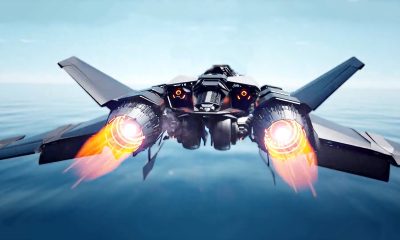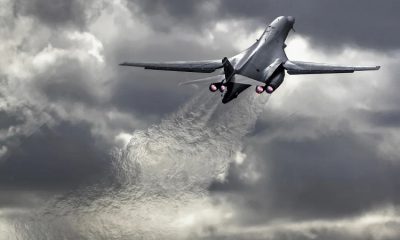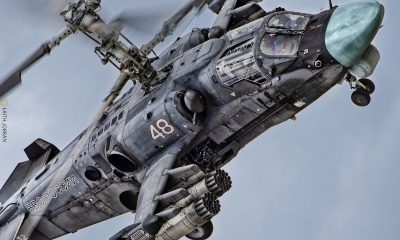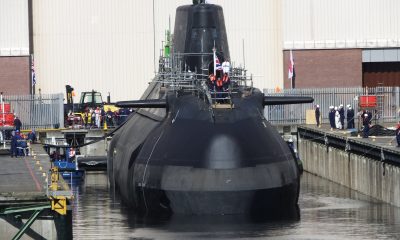Helicopters Military
10 Crazy Facts We Just Learned About The SR-71 Blackbird
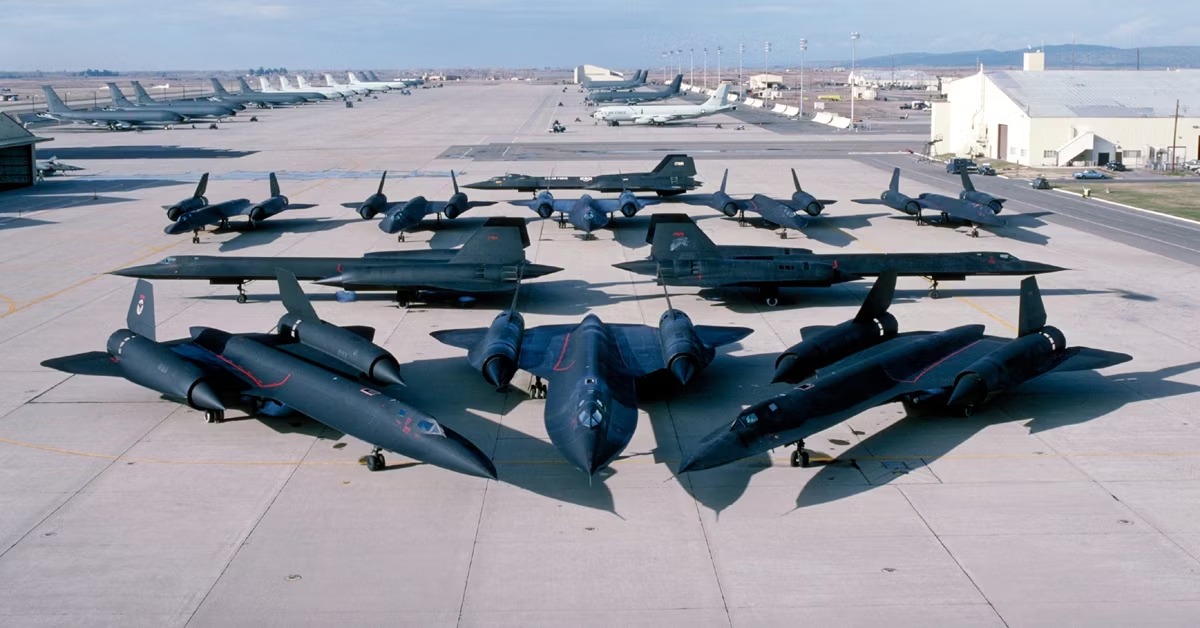
When the military U-2 spy aircraft became vulnerable to Soviet attack in 1960, specifically from their surface-to-air missiles, President Eisenhower told Lockheed to build the impossible. The goal was simple yet nearly insurmountable, to build an aircraft that could not be shot down. The final challenge was to do it, quickly.

Development began, and the new aircraft now had to exceed crazy speeds. There were plenty of challenges to overcome, from high-speed stability to atmospheric friction, to costs, and of course, the time factor. But Lockheed Martin persevered and so the Lockheed SR-71 Blackbird was born, taking its first flight with this designation on December 22, 1964.
The SR-71 Blackbird has been a vital part of USAF, especially as the Cold War started heating up, and more spy missions were needed to make sure America knew all the goings-on of the USSR. It sounds like the beginning of a spy novel, if you are hooked to this info, here go the pertinent facts about the SR-71 Blackbird.
10/10 2193-MPH Top Speed

When the SR-71 Blackbird was being made, the goal was to exceed 2,000 MPH. It ultimately did exceed the goal, flying to a record top speed of 2,193.2 MPH. But that’s hardly the most surprising aspect of this speed.
The other aircraft of the time could in theory exceed it, but the SR-71 could fly at these speeds for a long time. That of course created another lot of problems, related to atmospheric friction and heat. Conventional airplanes would melt at these temperatures.
9/10 The SR-71 Blackbird Was Multiple Record Setter

The SR-71 Blackbird set the record for being the world’s fastest, highest-flying air-breathing operational manned aircraft at the time. Meaning today’s drones could probably outfly it. That said; CNN still called it the world’s fastest airplane in a 2020 article.

The highest altitude recorded on an SR-71 Blackbird is 25,929 meters. The one record that it still holds is a cross-country flight, zipping from Los Angeles to Washington, D.C. in just 64 minutes 20 seconds.
8/10 The First Airplane To Use Titanium

Considering the prolonged high speeds at which the SR-71 Blackbird could fly, the atmospheric friction translated to high amounts of heat. In turn, this meant that an aluminum body would simply melt.

So, a titanium alloy was chosen to make the body, but of course, the problem came with the fact that the existing tools weakened the body. So titanium tools were made. But even so, dissipating the heat across the body became another challenge.
7/10 The “Blackbird” Moniker Comes From The Color

While the atmospheric friction across the edge of the aircraft led to incredible heat, flying at high altitudes meant the temperature outside the cockpit would be a freezing -60 degrees Fahrenheit. So the heat had to be spread across the surface of the airplane to stop the pilots inside from turning into icicles.
One of the designers remembered that black paint both emits and absorbs heat. So, the SR-71 was painted black, giving it a lethal appearance and earning it the moniker, “Blackbird.”
6/10 It Could Outfly A Missile

To any non-pilot, 2,000 MPH or 25,000 meters means nothing but mere mathematic numbers. To clarify, the SR-71 Blackbird could fly at the edge of space. So while it could not go to the moon, it went near enough to the edge of the Earth’s outer limits to be one impressive machine.
Plus, if anyone aimed a missile at it, it could outfly the missile, let it trail harmlessly behind it before decimation, or the missile ran out of steam.
5/10 The Titanium Itself Came From Enemy Territories

The titanium needed to make the plane came from a very unlikely source. The USA did not have major titanium sources, and neither did its allies. The sole country that made titanium in vast amounts, and was the greatest supplier of rare metal in the world turned out to be USSR.
So to spy on the Soviets, the US made a plane, from materials sourced from the Soviets, probably using a ton of bogus companies. If that’s not a great example of irony, we didn’t know what is.
4/10 No SR-71 Blackbird Was Lost To Enemy Fire

Because the SR-71 Blackbird could fly higher, faster, and stealthier than any other aircraft of its time, and also any other anti-aircraft weaponry, none was lost to enemy fire. That said; these airplanes (built-in a great hurry) were not the most reliable of military planes.
12 out of 32 Blackbirds went down to accidents, although it’s good to point out that these were not the easiest of planes to fly and usually needed a whole host of personnel just to make it ready to fly. At the time, launching one was akin to launching a space mission, with a countdown.
3/10 The Blackbird Pilots Had To Suit Up

The extreme heat, cold, and pressure of flying this fast and this high took a toll on the pilots. They had to wear special suits, a lot like space suits to protect them from the temperature and intense environment.
Despite the black paint and a freezing ambient temperature outside the cockpit, the outside glass of the cockpit used to get super hot. So much so, in case the pilots felt a little “peckish”, they could and did warm up meals by pressing it outside the glass.
2/10 No SR-71 Blackbird Flew Into Soviet Airspace

The Lockheed SR-71 Blackbird was developed under intense pressure after a USAF U-2 spy plane went down to Soviet gunfire in 1960. It was made keeping the Cold War in mind, to make sure the US knew what the USSR was up to and if the “coldness” would develop into something more physically violent.
That said, there was no need for any foray into Soviet airspace, at least officially. It did, however, perform missions in the Middle East, Vietnam, and North Korea.
1/10 Last Flown By NASA

The SR-71 Blackbird operated with absolute impunity, considering it remained one of the fastest jet-propelled aircraft in the world for decades. The Blackbird project was retired in 1990, then briefly brought back in the mid-90s before finally being retired.
The last flight of the SR-71 was by NASA in 1999 for high-speed and high-altitude aeronautical research. All surviving Blackbirds are now resting their laurels in various museums across the world.
Helicopters Military
5 Fastest Fighter Jets in the World Ever And Still Active Today

It is undeniable, that ancient or ancient fighter jets have become technology that has been reaping admiration to this day. For example, the F-15 Eagle and MiG-29 were rivals in their time. This of course cannot be separated from how today’s fighter jets are made.
By paying attention to the details and existing technology, a more modern fighter jet was formed. However, unfortunately not all modern fighter jets can satisfy today’s engineers and experts. In fact, in terms of speed, it is known that most of the ancient fighter jets dominated.
So, which are the fastest fighter jets in the world? According to the Bulgarian Military, here is a list of active and fastest fighter jets in the world!
Grumman F-14 Tomcat (2,485 km/h), USA

It is undeniable that the Tomcat is an older generation. In fact, the film Top Gun: Maverick illustrates how this jet lacks the features of today’s era. In this case, in fact the Tomcat is still used by Iran.
Grumman Aircraft Engineering Corporation is the manufacturer of that aircraft. Despite its age, it is known that it is a reliable interceptor that can accompany four targets at once while simultaneously capturing up to 6 targets.
Eurofighter Typhoon (2,495 km/h), Germany

Germany put its Armed Forces “Typhoon” representative into production in 2003. Most of the hull is made of a special coating that blocks electromagnetic waves, while the combat radius of the fighter aircraft is 1,390 km. This fighter jet is also owned by Britain and Italy. There are about 500 such fighters in the world.
Su-35 fighter jet (2,500 km/h), Russia

This aircraft is the most formidable fighter of the Russian Air Force, currently in service. This powerful fighter with two modern engines is a modern Su-27 fighter produced in Soviet times.
The Su-35 can climb to a height of 20,000 meters, perform aerobatics, and carry a sizeable payload. All these tactical and technical characteristics, coupled with advanced electronic equipment and weᴀponѕ, turn the Su-35 fighter into a dangerous foe for any foreign fighter.
Su-57 fighter jet (2,600 km/h), Russia

This aircraft is a Russian 4++ generation fighter. This fighter is characterized by the extensive use of stealth and artificial intelligence technologies. The electronics would take over most of the test work, freeing up pilots to carry out combat missions. The maximum speed of the Su-57 is nearly 200 km/h more than the American F-22 Raptor.
McDonnell Douglas F-15 Eagle (2 650 km/h), USA

This aircraft is the perfect leader in its class and is distinguished by excellent speed and maneuverability. The tactical all-weather fighter appeared in 1976, with production scheduled for 2025 to arm America. A total of 1,500 of these items are known to exist and all fighters are in the United States.
That’s the world’s fastest active fighter jet. Now, the fighter jet is still adorning the defense technology industry in various countries.
Helicopters Military
B-1 Lancer: This Bomber Is The Ultimate Survivor

The B-1 Lancer, nicknamed the “Bone,” is the United States’s only supersonic bomber. The B-1 compliments the other US bombers – the workhorse B-52 Stratofortress and the stealthy B-2 Spirit. Unlike the B-52 and B-2, however, the B-1 is capable of breaking the sound barrier. That the B-1 can hit Mach 1.2 is especially impressive given that the bomber also can carry a 25-ton payload.

Despite the B-1’s impressive capabilities, the bomber was canceled before entering service, and actually had to be saved from the scrapheap.
B-1: A History
During the Eisenhower administration, the US Air Force began looking for a new bomber – something that could combine the raw speed of the Convair B-58 Hustler with the hefting ability of the B-52. Initially, the North American B-70 Valkyrie – a bomber featuring six engines, which could reach Mach 3 and a 70,000-foot service ceiling – was selected.
Yet, improvements in the Soviet air defense systems, specifically their surface-to-air missiles, rendered the Valkyrie’s high-altitude flight more dangerous – which forced the Valkyrie to conduct bomb runs at lower altitude. That was a problem, however; at low altitudes, the Valkyrie suffered from higher aerodynamic drag – which limited the bomber to subsonic speeds and a short range. In effect, the Valkyrie was redundant – less useful even – than the already serving B-52. Accordingly, the Valkyrie program was canceled.

Multiple programs were formed to develop a bomber capable of supplementing the B-52 – which was poorly matched for low-level bombing runs. The programs, which hoped to find a long-term fix, included the Subsonic Low-Altitude Bomber (SLAB), Advanced Manned Precision Strike System (AMPSS), and the Advanced Manned Strategic Aircraft (AMSA) – neither developed much in terms of a tangible product, and were eventually limited when Secretary of Defense Robert McNamara steered the DoD away from bombers development and towards ICBM development.
President Richard Nixon brought AMSA back from the dead in 1969, however. North American Rockwell won the AMSA contract – edging out Boeing and General Dynamics – and began to develop the prototype which would become the B-1.
Development of the B-1 went smoothly enough through the 1970s – but then something unexpected happened. A Soviet pilot defected, bringing with him a heap of intelligence.
In 1976, Viktor Belenko landed his MiG-25 Foxbat in Japan. Belenko was an extremely valuable source of intelligence; among the tidbits he shared: the Soviets were developing a “super-Foxbat” (most likely the MiG-31) with an advanced radar system that would allow for the easy detection of low-flying aircraft (like the B-1). Belenko’s intelligence suggested that the B-1 would be functionally useless the minute it entered service.

Jimmy Carter, who was then campaigning for president, made responsible defense spending a cornerstone of his policy proposals.
Carter bashed the B-1 program in particular throughout his campaign – and when he was elected president, he ordered a study that resulted in the cancellation of the B-1 program.
THE LANCER MAKES A COMEBACK
It was not until President Ronald Reagan won the 1980 election, replacing Carter, that the B-1 program was renewed. Reagan had campaigned on the premise that Carter was a weak leader, weak on defense; Reagan cited the B-1 cancellation as a primary example of Carter’s weakness on defense-related issues.

So, predictably, when Reagan took office, he reinitiated the B-1 program, and in January 1982, the USAF ordered 100 B-1 bombers from Rockwell.
Politics almost prevented the B-1 from entering service – but the supersonic bomber got there, albeit in a roundabout way. The B-1 is still in service today but plans are in place to have the B-1 phased out by 2036.
Helicopters Military
AH-1W Super Cobra Is The First Attack Helicopter In The World – Honestly “Terrible”
Service: USMC Armament: 20 mm M197 Gatling cannon; Hydra 70 rockets; 5 in Zuni rockets; TOW missiles; AGM-114 Hellfire; AIM-9 Sidewinder. Speed: 170 knots Range: 58 nm Propulsion: 2x GE T700-GE-401 turboshaft engines Crew: 2

Originating from a concept demonstrator delivered to the U.S. Army in 1962 based upon a UH-1 Huey, the AH-1W Super Cobra is the world’s first attack helicopter. Marines have been flying the AH-1W Super Cobra since 1986. The last AH-1W was delivered in 1998.
The AH-1W is being replaced by the AH-1Z, starting in 2006 as part of a remanufacture program. The Last AH-1W is expected to be replaced in 2020. AH-1Ws are fielded in Marine Light Attack Helicopter Squadrons, or HMLAs, along with the UH-1N.
Super Cobra helicopters form the backbone of the Marine Corps’ air-ground task force and act as on-call close air support platforms for Marines under fire. Cobras are also used for ground attack coordination, with pilots trained to call in artillery or mortars on positions while orbiting above the battlefield.
The Super Cobra was the first attack helicopter to qualify both the Sidewinder air-to-air missile and the Sidearm anti-radiation missile. Both missiles can use the same LAU-7 rail launcher. Sidearm has a range of more than 15km. AIM-9L Sidewinder is an all-aspect, short-range, air-to-air missile produced by Lockheed Martin and Raytheon. The missile has a range of 15km.


